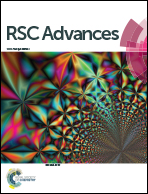Long-range proton relay shows an inverse linear free energy relationship depending on the pKa of the hydrogen-bonded wire†
Abstract
The long-range proton transfer dependence on the pKa of hydroxyl molecules in hydrogen (H)-bonded wires was investigated using quantum mechanical calculations. The triple proton transfer takes place in an asynchronous and concerted fashion between carboxylic and imidazole groups linked by two H-bonded chain molecules. Four hydroxyl molecules with different acidities, water, 2-fluoromethanol, 2,2,2-trifluoromethanol, and phenol, were used to construct sixteen H-bonded wires. The proton transfer rate increased with the acidity of the chain molecules. The rate was found to be more dependent on the particular chain molecule with relatively small structural changes in the wire, which can act as a solvent, rather than molecules with larger O–H bond cleavage in the TS. An inverse linear free energy relationship was recognized for the first time in the multiple proton transfer with a change in hydroxyl molecules. The activation and reaction free energies decreased and increased, respectively, with respect to the acidity of the chain molecules. This inverse LFER can be explained by the pKa slide rule, in which the pKa dependence of H-bond strength in a wire has an opposite trend for chain molecules that donate and accept a H-bond. Therefore, the pKa of wire molecules can have different roles, which leads to the very unusual relationship between the activation and reaction free energies.


 Please wait while we load your content...
Please wait while we load your content...